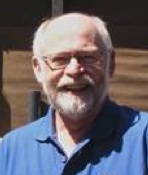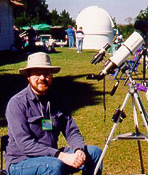<<PREVIOUS -
HOME -
CONTENTS -
NEXT>>
DOUBLE STARS INDEX -
![]()
<<PREVIOUS -
HOME -
CONTENTS -
NEXT>>
DOUBLE STARS INDEX -
![]()
The purpose of this project was to determine if double star angular distance and the position angle measurements can be successfully done with a motor driven alt-azimuth DOB (Dobsonian telescope) telescope without a field rotator and a DSLR (digital single-lens reflex) camera. Additional project constrains were to use exiting equipment and software as much as possible. The equipment included Apple MacBook laptop computer and a Canon EOS T2i DSLR camera. In addition this was Tom Frey's first time experience with astrophotography.
Introduction
David Haworth and Tomas G. Frey first met at the Alt-Az Initiative Student Research Summer Workshop at Pine Mountain Observatory, Oregon in August, 2010. Tom lead a team that did visual double star measurements and David Haworth lead a team that did spectroscopy measurements of stars, nebula and quasars. They met again at the Maui International Double Star conference in February, 2013. It was at the conference that they discuss a project to use Tom's 18 inch Obsession telescope with his Canon DSLR to take double star angular distance and position angle measurements based on short exposures in order to reduce field rotation affects in the image. Next, astrometric calibration of the image was used to determine the RA and Dec position of both double stars in the image. Finally, the double star angular distance (rho) and position angle (theta) was calculated from double star RA and Dec positions.
Summary
The the double star angular distance (rho) and position angle (theta) were successfully measured with short exposures up to 3.2 seconds using a Canon DSLR with an ISO of 800. As always in astrophotography focusing is a major challenge and should be checked often during the observing session. Exposure times have to be carefully selected so that the double stars are not over exposed or under exposed. Over exposed stars reduces the sub pixel resolution that is possible with correctly exposed stars. The benefit of astrophotography is being able to quickly take many images during the night observing session. Later, the image data is reduced and statics are used to increase the confidence in the results. Also, as skills over time increase in data reduction techniques the data can be reanalyzed in the future.
Links ![]()
References
|
|

Thomas G. Frey Thomas G. Frey is Professor Emeritus of Chemistry at California Polytechnic State University, San Luis Obispo, CA. He has been an active member of the Central Coast Astronomical Society for over 25 years. He was a team leader at the Pine Mountain Observatory (PMO) Summer Science Research Work- shop, Bend, OR, 2009 and co-director of the PMO workshop, summer of 2011. |
|
|

David Haworth enjoys astronomy imaging and processing those images to bring out details that cannot be seen easily by visual observing with the same size optics. David Haworth started astroimaging with a Cookbook CCD camera he built in 1996 and since then has used many types of cameras to image the sky. David wrote Chapter 2: "Afocal Photography with Digital Cameras" in the second edition of "The Art and Science of CCD Astronomy" which was published in December 2005. David's images have appeared in magazine front covers, articles, books, catalogs, videos, music CD covers, T-shirts, other web sites, etc. |